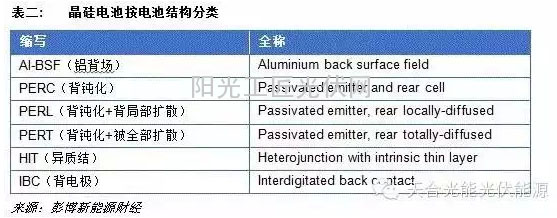In 2015, many new terms were placed in front of crystalline silicon cells to be modified to make a difference. Before discussing their respective market prospects, let's take a look at the essential differences between various batteries. Basically can be divided according to two systems: silicon material, battery structure.

Explain various terms in one sentence:
Polycrystalline: Small crystal particles, the same volume corresponds to more particles.
Single crystal: The crystal particles are large and the same volume corresponds to fewer particles.
(Note: Since free electrons will recombine at the crystal particle boundaries and return to the bound state, they cannot contribute current. Therefore, the smaller the particles are, the more the same volume corresponds to more particles and the more frequent electron recombination is, so the efficiency of polycrystalline cells is lower than Single crystal battery.)
Type N: Silicon in the fourth group of the periodic table is mixed with phosphorus of the fifth group, and there are more electrons that can move freely, showing negative polarity.
P type: Silicon in the fourth group of the periodic table is mixed with boron of the third group, with less electrons that can move freely, showing a positive polarity.
(Note: The material properties determine that free electrons are more likely to recombine in the p-type material to the bonded state, so the n-type material makes the battery more efficient.)
Aluminum back field: The back of the battery is coated with aluminum, penetrates into the silicon material, forms a local electric field, and blocks free electrons from flowing toward the back surface.
Back Passivation Series: The common feature of the three types of back passivation (PERC/PERL/PERT) structures is the addition of a passivation layer on the basis of a traditional aluminum back-field to better block electrons from recombination on the back surface. PERL and PERT are enhanced versions of PERC because after the passivation layer is heavily diffused (partially or totally) with the same polarity as the silicon wafer, another back electric field is formed.
Heterojunction: Both crystalline and amorphous grades of silicon are present in the cell; the presence of amorphous silicon achieves a better passivation effect.
Back Electrode: The positive and negative electrodes are placed on the back of the cell. There is no shadow loss due to reflection of some of the incident light by the front electrode portion (silver paste).
Theoretically, the definitions of Table 1 and Table 2 are based on different standards. Various combinations can be used. However, in the actual preparation process, some battery structures correspond to high production costs and need to be made more efficient with better silicon chips. The battery to support its economy, so only the following combinations of commercial products:
Aluminum back field: single crystal (p-type), polycrystalline (p-type). Most manufacturers' batteries are aluminum back-field structures.
Back passivation series:
PERC: single crystal (p-type), polycrystalline (p-type). Examples include TRW HoneyPlus, Hanwha's Q.ANTUM, and Suntech's HyPro.
· PERL: Single crystal (p-type). For example, Crystal Australia's Percium.
PERT: Single crystal (n type). For example, Panda of Yingli, MilkyWay of Aerospace, MonoXNeON of LG.
Heterojunction: Single crystal (n-type). For example, Panasonic's products.
Back electrode: single crystal (n type). For example, SunPower's products.
According to the efficiency from high to low: back electrode, heterojunction, PERT, PERL, single crystal PERC, single crystal aluminum back field, polycrystalline PERC, polycrystalline aluminum back field.
Steal Cnc Milling Parts,Stamping Parts Stainless Steel Parts,Custom Metal Factory Deep,Deep Drawing Stamping Parts
JIANGSU TONGDE INTERNATIONAL TRADE CO.LTD. , https://www.tongdetrades.com